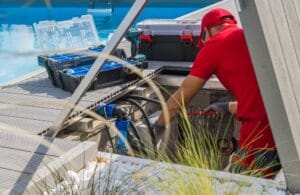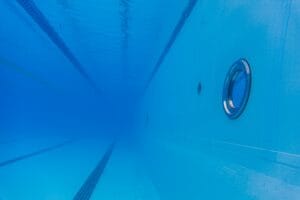First, electrocatalytic oxidation method of sewage treatment technology principle
1, electrochemical water treatment technology
The molecules of any substance are composed of atoms, and atoms are charged system, so in any chemical reaction, atoms and atoms interact with electrical phenomena occur. Electrochemical water treatment technology is to treat pollutants in water through the relationship between chemical and electrical phenomena of organic and inorganic substances in wastewater.
Electrochemical technology is divided into two parts: a part of the micro-electrolysis (primary cell reaction) technology, is the conversion of chemical energy into electrical energy is considered a reversible process; the other part of the electrolysis (electrolytic cell reaction) technology, the conversion of electrical energy into chemical energy for the process of the irreversible reaction of the battery, whose essence is the particles of the aqueous phase and the solid phase for the electrode material interface between the electrode reaction.
2, electrolytic cell electrode reaction
The main process of wastewater treatment using multi-dimensional electrode method, through the electrodes on the surface of the electrocatalytic degradation occurs, the electrode can be directly generated by the strong oxidation capacity and organic and inorganic substances without selective hydroxyl radical [-OH] (ε ° = 2.80v, p = 569.3Kj) to oxidise pollutants in water, so that the pollutants are thoroughly mineralised, known as the electrochemical combustion process; if the aqueous solution If the aqueous solution contains electrolytes like CI -, SO42- such as with: sodium sulfate, chlorine, hypochlorite and chlorate. Generated peroxides such as S2O82-, H2O2, etc. catalytic oxidation of pollutants in the water, the process is called electrochemical conversion process, so that electro-oxidation effectively remove COD from wastewater.
A) Some of the main reactions in the electrolysis process are as follows: (non-chlorinated wastewater)
Anodic reaction: OH- →1/ 2O2 + H2O + 2e-
Cathode reaction: O2 + H2O + 2e-→ HO2- + OH-
Total reaction: 1/2O2 + OH- → HO2-
Electrolysis produces peroxyl radicals [HO2-], which, under alkaline conditions, cause secondary reactions in the wastewater, resulting in the degradation of pollutants or their direct decomposition into CO2, or conversion into other simple compounds.
The electrolysis process obeys Faraday’s law. That is, the amount of material precipitated on the electrode is directly proportional to the strength of the current through the solution and the time of energisation. Similarly, the removal of organic pollutants from wastewater obeys Faraday’s law. In the process of removing organic pollutants in wastewater, does not need to be completely oxidised into the final product that is, CO2 and H2O, but only need to break the chain of organic pollutant molecules, torn into charged organic ‘debris’, through electrolysis, adsorption, flocculation and sedimentation to remove organic pollutants.
B) Some of the main reactions in the electrolysis process are as follows: (Chlorinated wastewater)
Electrode process is: anode reaction precipitated chlorine dissolved in the electrolyte to generate HCL and HCLO, cathode precipitated H2 after the production of OH- ions, the anode produced by the neutralisation of H+, generating H2O and NaCLO:
HCLO→H++CLO-
HCLO+Na++OH-→NaCLO+H2O
Total reaction formula: NaCL+H2O→NaCLO+H2
NaCLO has strong oxidising properties with drifting, disinfecting and sterilising ability. Working principle in sewage treatment: indirect oxidation treatment of sewage.
1.2 Electrocatalytic oxidation reactor treatment of sewage reaction type
1.2.1 Direct electrolysis
Direct electrolysis in electrochemical technology means that pollutants are removed from wastewater by being oxidised or reduced directly at the electrode. Direct electrolysis can be divided into an anodic electrode process and a cathodic electrode process. The anodic electrode process means that the pollutants are oxidised on the anode surface and transformed into smaller substances or easily biodegradable substances, or even organic inorganisation, so as to achieve the purpose of reducing and removing pollutants. Cathode electrode process is the pollutants in the cathode surface reduction and removal, mainly used for halogenated hydrocarbons reduction dehalogenation and recovery of heavy metals and so on.
1.1.2 Indirect electrolysis
Indirect electrolysis of electrochemical technology refers to the use of electrochemically generated redox substances as a reactant or catalyst to convert pollutants into smaller substances. Indirect electrolysis is divided into reversible and irreversible processes. Reversible processes (mediated electrochemical oxidation) are those in which the redox substances can be electrochemically regenerated and recycled during the electrolysis process. Irreversible process refers to the process of oxidising organic matter using substances produced by irreversible electrochemical reactions, such as chlorate, hypochlorite, H2O2 and O3 with strong oxidising properties, and also using electrochemical reactions to produce strongly oxidising intermediates, including solvated electrons, -OH, -HO2, O2- and other free radicals, to carry out the redox reaction to form new material particles for removal or mineralisation.
Titanium anode
Second, the superiority of electrochemical water treatment technology
(1) High environmental compatibility
Electrochemical water treatment technology using clean, effective electrons in the electrolysis process does not need to add another oxidising agent or reducing agent, flocculants and other chemicals, is a basic environmentally non-polluting ‘green’ treatment technology. Due to the interface electric field there is a very high potential gradient, the electrode is equivalent to the catalyst of heterogeneous reaction, thus reducing the environmental pollution that may be brought about by the addition of catalyst, in the electrolysis process itself at the same time also produces -OH radicals can be directly reacted with the organic pollutants in the wastewater, degraded to carbon dioxide, water and simple organic matter, there is no or very little secondary pollution. Secondary pollution, at the same time, the electrochemical process has a high degree of selectivity, can prevent the generation of side-reaction products, reduce the occurrence of pollutants.
(2) Multifunctionality
Electrochemical processes have direct and indirect oxidation and reduction, phase separation, concentration and dilution, biocide and other functions, high energy efficiency, electrochemical processes can generally be carried out at room temperature and normal pressure;;
(3)Economical
Electrolysis equipment and its operation is generally simple, low cost, small footprint, generally into a modular combination.
(4)Very strong oxidising ability.
(1) Hydroxyl radical (OH) oxidation is extremely strong, second only to fluorine (F2), much stronger than ozone (O3).
(2) The chemical reaction of oxidative degradation of organic matter by OH radicals is a chain reaction, which means that once the oxidation reaction occurs, as long as no inhibitor is added, the reaction will continue in a continuous cycle.
(3) The degradation of organic pollution compounds is thorough (sometimes it can be oxidised to carbon dioxide and water) and universal (any organic matter can be oxidised and degraded).
Three, electrocatalytic oxidation reactor equipment structure introduction
- The anode plate of the electrolysis equipment adopts combined or detachable connection, and the combination of the anode plate is determined according to the water quality of different sewage. The anode plate adopts high oxygen precipitation potential, and the oxygen precipitation over-potential can reach 1.93v (relative to the glymercury electrode).
- the bottom of the equipment adopts microporous aeration device, on the one hand, in the process of electrolysis can be fully stirred anode plate generated hydroxyl radicals (-OH radicals) to fully react with the organic matter in the sewage, on the one hand, can be supplemented in time to degrade part of the COD in the sewage in the active oxygen.
- The bottom of the equipment is equipped with a sludge discharge device, which can regularly discharge the complex precipitation formed in the process of electrolysis of sewage. The operation is convenient and operable.
- The equipment has its own circulation and air extraction system. The flow rate can be adjusted according to the difficulty of sewage treatment, and the retention time and reaction time of sewage in the electrolysis tank can be controlled.
- Electrocatalytic oxidation equipment is generally used for high difficulty in degrading wastewater and end wastewater after biochemistry.
- Generally formed into a modular type, the electrolysis method usually adopts cyclic electrolysis.







